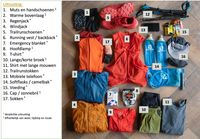gear and clothing
If you go into the mountains, you automatically come into contact with the part of equipment. To move safely, efficiently, and comfortably, it is important that you have the right clothing and equipment and also know how to use or apply them. In your preparation for a trail event or trip, it is important to pay attention to your gear and the season you are heading in to? What are the expected weather conditions, how stable is the climate at that time of year, how long do you expect to be on the road, etc. etc.
Something that is especially important in high-intensity activities is weight. Everything you want to carry with you, you have to carry running for several hours or days. So the lighter all items are, the less total weight you have, the faster, and therefore the safer you are. Because in mountainous terrain, speed is also a form of safety.
Each item individually seems very light, but put them together on a scale and you will quickly have several kilograms. If, for example, out of 10 items you take with you, you can save 50 grams per item, you then have to take half a kilo less, or you can take an extra 0.5L of sports drink with you.
Clothing
To start with one of the most important: clothing. Trail and mountain running are high-intensity activities that make specific demands on the clothes you put on. Especially when combined with the local temperature, wind and precipitation. As a runner, you probably know what you put on in warm weather and in cold weather or when it rains, but whereas in the Netherlands you can get wet again during a training run or be 'momentarily' cold before you get home safely, in the Alps this can turn out differently. And especially when planning goes differently than expected. For example, if the weather suddenly turns or someone in your group falls and you suddenly find yourself stuck in the elements.
The most important thing when it comes to clothing is to have the right items with you in case the weather or your planning changes. For this, the minimum you need to have with you while trail running in the Alps is the following:
- Waterproof jacket, Obviously to keep you dry during your long and beautiful adventures through the alps. Rain is not a 'show stopper', but in the mountains you are quickly on the move for a few hours to a day and when you get tired it takes more energy for your body to keep you warm. If you are also wet in the process, the danger of hypothermia is just around the corner. This can happen as early as temperatures above 0 degrees. Look especially for brands that use goretex such as the goretex shakedry or paclite. These are good breathable membranes that have a high water column (in trail racing, the minimum requirement is 10,000 mm) and high breathability. Last but not least, a low weight.
- Midlayer: This is a warm layer that you pull over your sports shirt and fit under your rain jacket, preferably one with a hood. If you stand still on a beautiful mountain peak for a break or unexpectedly have to continue walking slowly because you hurt yourself during a fall, it is important not to cool down. Your intensity changes suddenly, so it is necessary to adjust your clothing. Especially in emergency situations when the weather changes, there is a risk of hypothermia. And it is also just comfortable to be able to put on something warm. Materials such as Polartec, fleece or extremely thin down jacket (puffy) are good for this.
Furthermore, based on the weather forecast, duration and intensity of your route, you can make choices such as taking the following items:
- Waterproof pants
- Gloves
- Wind jacket
- Beanie
- Suncap
- Long running thights
- Extra long sleeve shirt or separate sleeves
In the end, you have a total clothing system for yourself with which you can make on route adjustments as conditions change. In any case, make sure you have a warm layer and waterproof jacket. These two together provide protection for your core (vital organs) when circumstances put you in an emergency situation.
Gear
Trail run pack:
Your gear starts with a good trail vest or backpack, one that is comfortable and has the right volume to carry everything you need. If you are going for a quick sky race then a race belt or super-light vest for just your drink, a bar and a rain jacket will probably be enough, but if you are joining the Alprunning Expert trip, then you will need more volume because you will be staying overnight in mountain huts and taking everything for 1 week by yourself. Choose your volume based on your event, trip or alpine project and also think about what you might want to do the following year, a good vest will last a long time, so it should also be future-proof.
Hydration system:
You take drinks with you in the form of sports drinks and it is easiest to carry them in soft-flasks, these fit well in your trail vest and when empty, are nice and light. How much you take depends on the duration, intensity, temperature and opportunities to refill along the way. Minimum is two soft-flask with 0.5L of sports drink each. Want more? Consider a drinking system with hose (extra 1.5L) or, for example, an extra soft-flask. The more you take with you, the heavier your trail vest. Plan your route carefully and use nature or facilities along the way.
Trailrunning poles:
A must-have when you trail run the Alps. You use these during the climbing sections. In the Alps, you frequently have to climb sections of at least 500-1000 of vertical at a time. By using poles, you can climb more energy-efficiently and thus you can easily continue longer or faster in a mountainous environment. During trail running trips, we also dwell on technique. Because if you don't use them quite right then they will be more in the way and you won't get the benefits. The poles should be foldable into at least 3 parts, so they can be put in or attached to your trail vest for the descents and the stretches of running. During the descent, you need to be able to concentrate and rely on footwork, poles will just get in the way.


